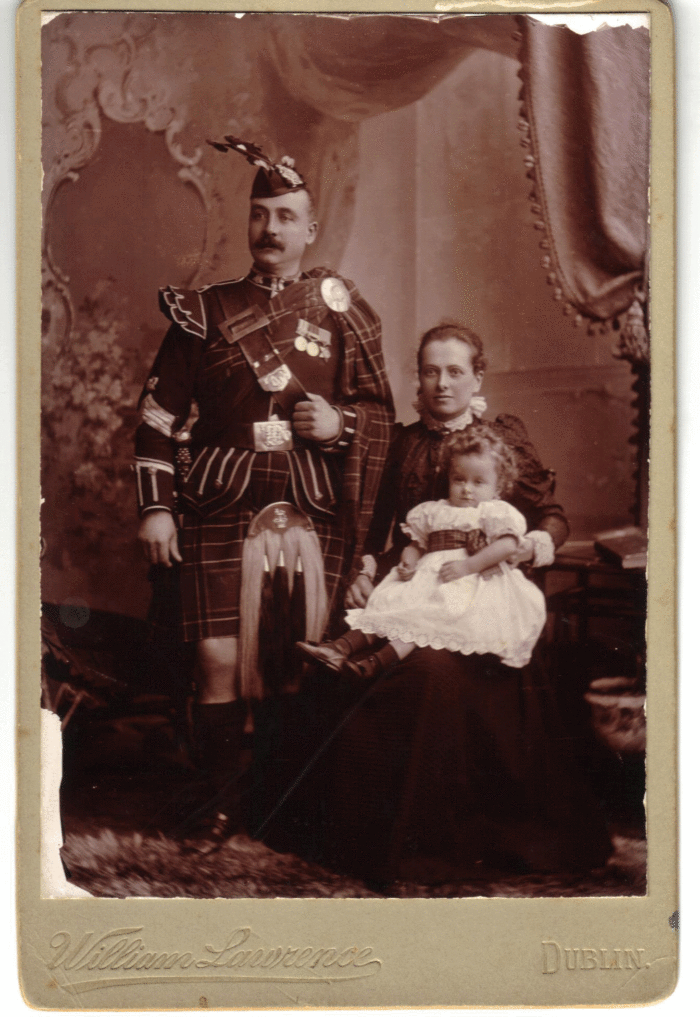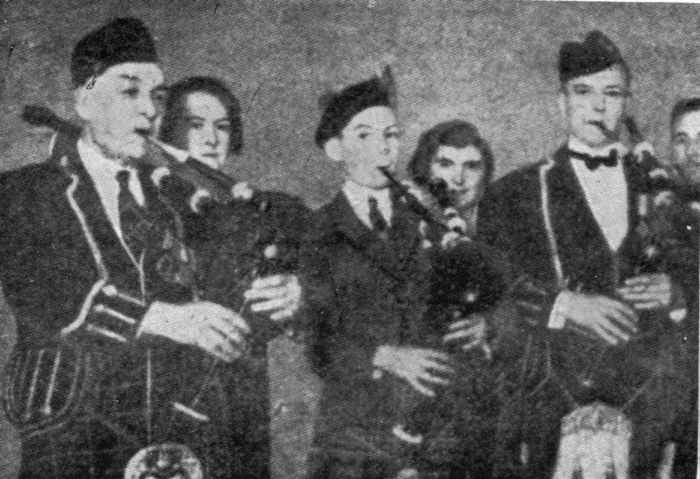John Balloch
(circa 1860-1947)

Very little public information has previously existed on John Balloch, and most was derived from a biographical entry in C. A. Malcolm’s The Piper in Peace and War (1927), which appears as follows:
Balloch, John – The noted composer of “The 25th’ K.O.S.B.’s Farewell to Meerut” joined the army in 1878 as a piper in the 57th Brigade, which comprised the 42nd and 79th Highlanders, and played his pipes with the leading company of the 79th in the battle of Tel-el-Kebir during the famous charge, and right through the Egyptian Campaign, 1881-84, was conspicuous as a piper. Was transferred as pipe-major to the1st Battn. K.O.S.B. in 1886, and led the pipers of that battalion on the expedition to Upper Burmah. Retired 1899, and became pipe-major to the 5th Argyll and Sutherland Highlanders (Greenock). In 1914 rejoined his old regiment and was posted Pipe-Major 8th Battn. K.O.S.B., with which he served in France from July 1915-18, when he was invalided home. Even then he was not allowed to be lost to the army, for the 9th Officers’ Cadet Battalion of Gailes appropriated the services of the distinguished pipe-major. In addition to his “25th K.O.S.B.’s Farewell to Meerut,” Balloch has to his credit a marching tune entitled “Auchmountain’s Bonnie Glen,” and a melody for Retreat which he has named “Sunset in Flanders.”
He was born on November 29, 1860 at Burnfoot, Falkirk, near Stirling, son of William Balloch, an iron moulder, and Helen (Oswald) Balloch. He was well known in his day as a composer, with a number of his tunes published in James Robertson’s (Royal Scots) book of bagpipe music. Unfortunately, many of the tunes in this book don’t list the composer. His compositions were popular enough that long after his death his son continued to receive royalty payments for performances of his tunes on the BBC.
Though he retired as a Pipe Major around the turn of the century and opened a tobacconist shop in Greenock, he and his older son Donald enlisted when the Great War started in 1914. John was 54 and Donald was 17 and they served in the trenches together. He also had a second son, Ian Allister, born in 1901. John Balloch was awarded the Meritorious Service Medal in 1932.
He remained a popular figure for many years after his retirement, and this report from theGreenock Telegraph and Clyde Shipping Gazette from June 18, 1927, provides some insight into his celebrity and what was clearly a rich piping life:
Pipe-Major M. Balloch, M.S.M., has been appointed by the Committee of the Glasgow Police Athletic Club to act as judge for the Invitation Pipe Band Contest of the twelve great pipe bands of Scotland, at their annual sports, Ibrox Park.
Pipe-Major Balloch conducted the mass bands at the Diamond Jubilee of Her Majesty, Queen Victoria. His compositions include “25th K.O.S.B.’s Farewell to Meerut,” and “Auchmountain’s Bonnie Glen” which took premier honours at Cowal Highland Gathering and Scotstoun, in the band contests.
Pipe-Major Balloch first introduced the combination of pipe-organ and Highland bagpipe in a concerted piece in Greenock Town Hall, which was a success. He is piper to the Greenock Highland Society, Burns Mother Club, Innerkip Society, and Pipe-Major of the Greenock Police Band. The Pipe-Major served wtih the 79th Queen’s Own Cameron Highlanders and King’s Own Scottish Borderers.
Some years later, the same publication would publish a more detailed recollection of Balloch’s life. This article was published in the March, 1935 edition of The Borderers’ Chronicle, the newsletter of The King’s Own Scottish Borderers:
PIPING THROUGH A LIFETIME: PIPE-MAJOR BALLOCH’S VARIED CAREER
DIAMOND JUBILEE RECOLLECTIONS
What a familair figure in the every-day life of Greenock is Pipe-Major John Balloch. Yet how few know the long story of his services in different parts of the world.
Seeing him now, as he goes about in his quiet civilian dress, with hardly a trace of the traditional stride and swagger of the piper, it is hard at first to realize that there goes one of the best-known pipers in the Army, a man who has seen active service in several wars, and who was in charge of massed pipers when they played to Queen Victoria at her Diamond Jubliee.
If one left it to Pipe-Major Balloch, the story of his experiences would never see the light. For, like most men who have “done things,” he doesn’t want to talk about them. He dislikes the limelight. He abhors being questioned by journalists. Only very reluctantly could he be persuaded to give a “Telegraph” representative some details of the things he has seen and done in a long and adventurous life.
When Balloch first took the shilling in 1878, there were only five kilted regiments in the Army. These were the 42nd (Black Watch), 78th Seaforth Highlanders, 79th Cameron Highlanders, 92nd Gordon Highlanders, and 93rd Sutherland Highlanders. Since those days, many changes have taken place, and there are now ten regiments wearing the kilt, a transformation in favour of Scottish dress which can be partly traced to the persistent championing of the filibeg by our local hero.
In 1882 he went out with his Regiment to the Egyptian War, and was present at the battle of Tel-el-Kebir, being Piper to the leading company of the Highland Brigade at that engagement. He was afterwards transferred to the King’s Own Scottish Borderers, then stationed in India, and subsequently in Burma.
Under General Penn Symons, who was killed at the battle of Dundee in the South African War, Balloch saw active service in the Chin Lushai Expedition. He was also on active service in the Great War.
Piping was not his only pastime. While in India he took a keen interest in rifle-shooting, and, in addition to winning the prize for the best shot in his Regiment, was one of the successful team in the competition for the Cup presented by the Commander-in-Chief (Lord Roberts) and open to the whole of India.
By the time Queen Victoria’s Diamond Jubilee was celebrated, Balloch’s eminence as a piper was widely recognized, and he was selected to take charge of the massed pipers who played to Queen Victoria at the pavilion at Aldershot in 1897. On the occasion of the presentation of Colours to the Territorial Battalions he had also the honour of playing the massed Detachments to the field.
The pipes have been Balloch’s life-long interest — playing, teaching and composing for them. In India he even taught the Gurkhas, the sturdy little fellows of the Native Regiments, to play the pipes. This was an experience of which the Major retains happy memories. “I have never come across more apt pupils,” he said. “They played like regular Highlanders. I remember having occasion to pass their quarters late one night, and they were going full blast at the chanters.”
He has composed many stirring tunes for the pipes, but amongst his best is one inspired by a local poetess and bearing the title of “Auchmountain’s Bonnie Glen.” This has been the test piece at Highland gatherings, and as its beauty is discovered is likely to be more and more given preference in coming competitions for bands throughout the country. He is also the composer of another notable piece of pipe music, “The 25th’s Farewell to Meerut,” a composition inspired by his service in India.
The Pipe Major has a vivid memory of the great Kaid Maclean, of Morroco fame, whom he met while in Gibraltar. He played the pipes in honour of that famous Scot, who had become a potentate, wielding the powers of a ruling Sovereign in the land of his adoption. The Pipe Major recalls his wonderful personality, and the interest and regard he showed for the pipes and the music of Scotland.
Since he came to Greenock, Pipe-Major Balloch has had a busy life, and few events of a public or military character have taken place in which his figure was not a conspicuous one. He had a long association with the 5th Argyll and Sutherland Highlanders, and in his time was one of the most popular of recruiting sergeants. Highland Gatherings in the Town Hall found him always there, and he has had the privilege of leading many outstanding chiefs to the place of honour on the platform. Among those may be mentioned the Duke of Atholl, the Duke of Montrose and the Duke of Argyll. When in full regimentals, he displays a breast of medals symbolic of the campaigns he went through in his early years, and later in the Great War.

As will be seen from our photograph reproduced opposite on page 24, there are now three generations of pipers represented in the Balloch family — the Major, his son Donald, and his grandson Ian. The traditions are being worthily upheld by his successors, and are likely to be for many years to come. In his closing years the old piper and warrior of the past has the comfort and companionship of a worthy helpmate, Mrs. Balloch, who shares his happy memories of the past.
John Balloch died on September 3, 1947, Thomson Home, Rothesay on the Isle of Bute at 86. His profession was listed as ‘Pipe Major, Retired.’ His wife, Elizabeth Ann (Porteous), had died two years earlier at 85.
JM, June 2007
-with notes from Mssrs. Stuart and Jack Herron, John Balloch’s great grandsons, and ‘The Borderers’ Chronicle’; photo from ‘Music of the Scottish Regiments’, 1994, by David Murray.

4 Comments
Hello Jim
I’m a Breton piper, and just celebrated my 5O years of piping
I’m still wondering about the origin of ” The Dunkirk boatman ” retreat march
Considering that John Balloch was not implied in WWII, that tune cannot have connexion with the Dunkirk battle disaster in 1940, when gallant boatmen came to embark British and French soldiers, to take them back to England during the siege of Dunkirk
So, please, can you tell me the reason of the title of that tune ?
Many thanks
Jean Michel Platen
Sorry, Jean, I’ve looked up every published source for this tune and no one gives a story behind the title. Balloch didn’t pass away until 1947, so it is still possible that he wrote the tune to commemorate the Dunkirk evacuation, or at least gave the title to a tune he’d composed earlier. The tune was unpublished until 1976 when it appeared in Donald Varella’s book, further suggesting it may not have been written (or titled) until at least 1940. Neither Varella’s book nor Scots Guards III provide any notes. JM
Jim
Please, find here a comment left at the bottom of the page of that tune on Pipetunes, which explains the origin of the tune, it’s really unexpected :
The Dunkirk Gallant Boatman was first published in the United States Bicentennial Collection Vol 1 and much later entitled The Dunkirk Boatmen in Scots Guards Bk 3. It was composed by P/M John Balloch who spent his retirement years living in Port Bannatyne, Isle of Bute where he died in 1949. He was known by the locals simply as ‘the Pipe Major’.
The tune was composed for Alistair MacMillan of Port Bannatyne who was a sailor with the Caledonian Steam Packet Company and who took part in the Dunkirk evacuation rescuing British and French forces in 1940 under constant attack from the Luftwaffe. When informed of the tune Alistair told the Pipe Major that he had not been alone and therefore the title should refer to ‘Boatmen’, not ‘Boatman’.
Do we know which pipe tunes were favourites of Queen Victoria?